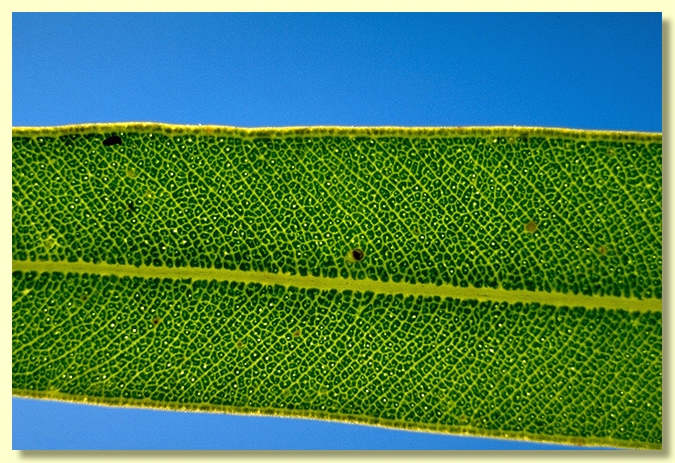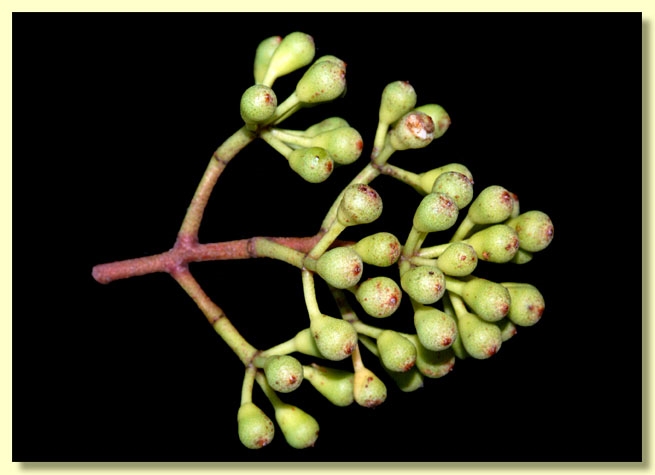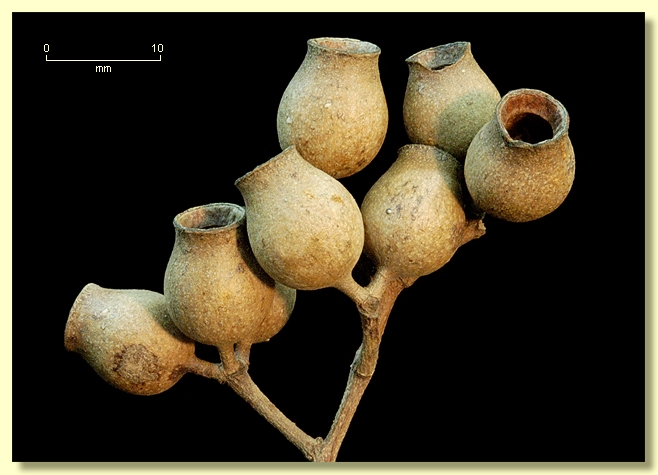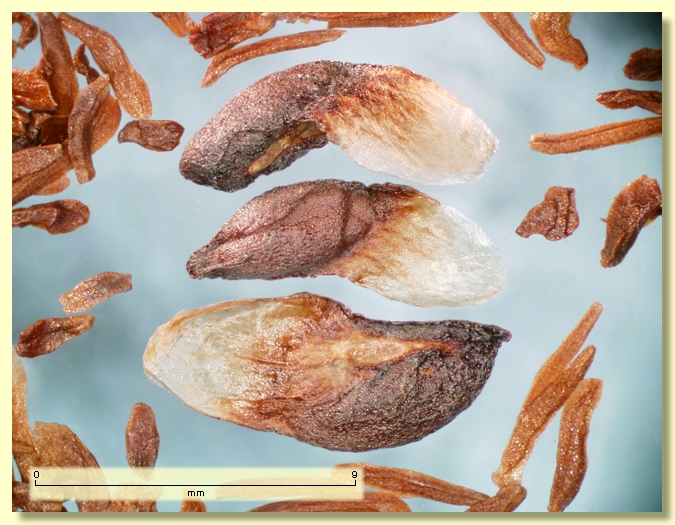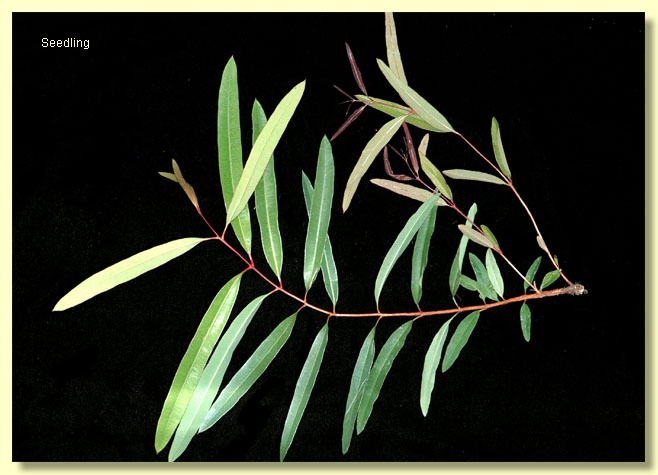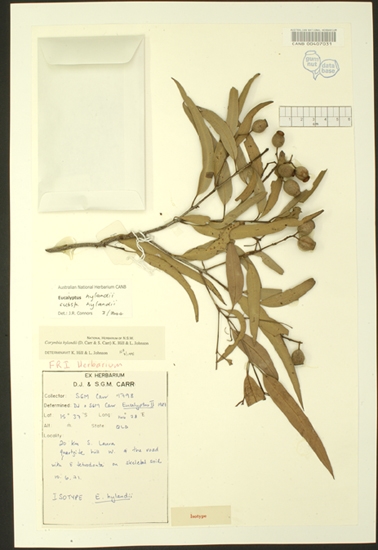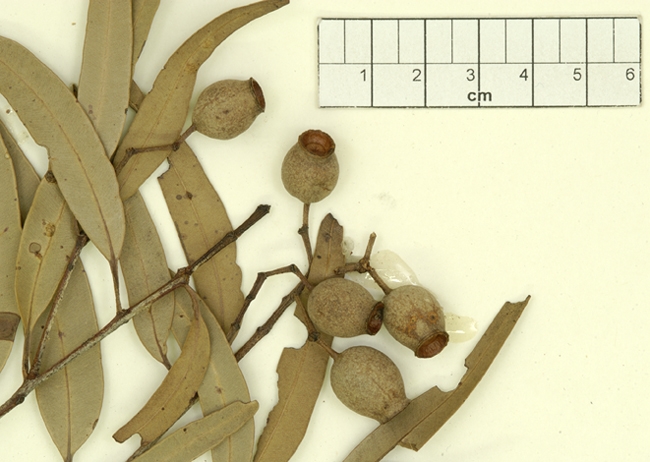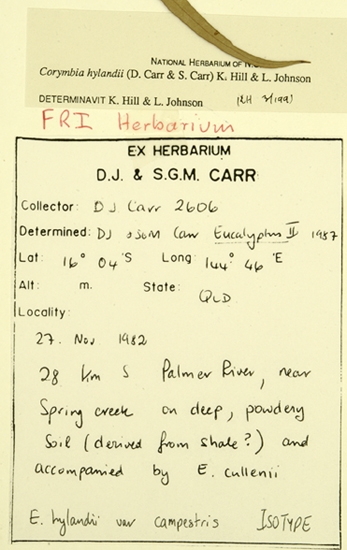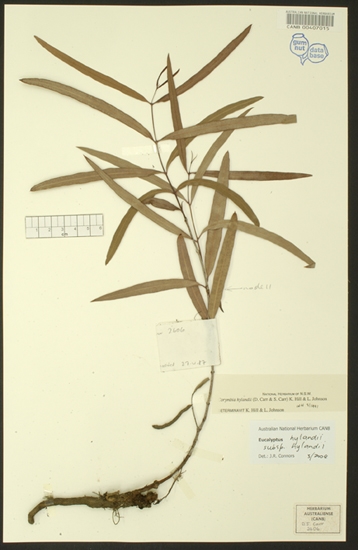Euclid - Online edition
Corymbia hylandii
Corymbia | Rufaria
Corymbia hylandii (D.J.Carr & S.G.M.Carr) K.D.Hill & L.A.S.Johnson, Telopea 6: 283 (1995).
Small tree commonly to 5 m tall, sometimes to 15 m tall. Forming a lignotuber and also rhizomes.
Bark rough over trunk and branches to ca 2 cm diameter, thick often corky and flaky, deeply tessellated, grey-brown over light brown.
Branchlets smooth (glabrous); elongated oil bodies sometimes present in the pith.
Juvenile growth (coppice or field seedlings to 50 cm): stems rounded in cross-section, setose or smooth (glabrous); juvenile leaves always shortly petiolate, opposite, linear-elliptic to linear-oblong, 3.5–8 cm long, 0.4–1.5(2) cm wide, base tapering to petiole or rounded, apex pointed, glossy, green, discolorous, glabrous.
Adult leaves alternate, petioles 0.7–2.5 cm long; blade lanceolate, (7.5)8.4–19.5 cm long, 0.9–2.5 cm wide, base tapering to petiole, margin entire, apex finely pointed, discolorous, dull to slightly glossy, green, smooth, side-veins greater than 45° to midrib, reticulation dense to very dense, intramarginal vein present but close to margin and more easily seen from underside, oil glands island, one per areole or sometimes absent.
Inflorescence terminal compound, peduncles slender 0.4–1.2 cm long, buds 7 per umbel, pedicels 0.3–0.8 cm long. Mature buds pyriform to obovoid or ovoid, 0.5–0.7 cm long, 0.3–0.5 cm wide, smooth not scurfy, scar absent (both opercula shed together at flowering), operculum shallowly rounded, stamens inflexed, all fertile, anthers oblong, dorsifixed, versatile, dehiscing by longitudinal slits, style long and straight, stigma blunt but with a fringe of papillae visible, locules 4, the ovules not arranged in clear rows on the placentae. Flowers creamy white.
Fruit pedicellate (pedicels (0.1)0.3–0.8 cm long), urceolate with a short erect neck with rim scarcely flared, 1–1.8 cm long, 0.8–1.2 cm wide, surface smooth and sometimes speckled, disc descending vertically, valves 4, enclosed.
Seeds brown, 7–11 mm long, ellipsoidal with terminal wing, hilum ventral.
Cultivated seedlings (measured at ca node 10): cotyledons reniform; stems rounded in cross-section, setose with bristle-glands for 6 to 11 internodes then glabrous; leaves shortly petiolate (to 1.2 cm), opposite, linear-oblong to narrowly lanceolate, 5–15(17) cm long, 0.6–2.5 cm wide, base tapering to petiole, lower leaves dull and sparsely setose on both sides, but at ca node 5–8 becoming slightly to very glossy green on upper side, paler on under side, and glabrous. Simple white hairs absent.
Flowering has been recorded in April and June.
Small woodland tree endemic to the southern Cape York Peninsula area of north Queensland, from Bathurst Bay to Laura and the Desailly Range, where it favours slopes on massive sandstone and granite outcrops with skeletal sandy soil. Corymbia hylandii has thick rough bark throughout and dull or only slightly glossy discolorous adult leaves, small smooth buds in terminal inflorescences, urceolate fruit and ± linear discolorous glabrous juvenile leaves.
Corymbia hylandii and the closely related C. stockeri are often confused. C. stockeri subsp. stockeri differs in having glossy green discolorous adult leaves and broader more elliptic-oblong to lanceolate juvenile leaves that are glossy above and setose on underside and on the stem. The more widespread Corymbia stockeri subsp. peninsularis differs from C. hylandii in having thinner, redder rough bark that only extends over the trunk and sometimes the larger branches with the limbs being predominantly smooth-barked, glossy green discolorous leaves and elliptic-lanceolate glossy green juvenile leaves that are broader than in C. hylandii but become glabrous after a few nodes.
Corymbia nesophila and C. hylandii are also very similar. Corymbia nesophila is widespread in northern Australia and on Cape York it occurs from Cooktown to Bamaga on laterite sites. It differs profoundly from C. hylandii in the juvenile leaves which are moderately large, usually ovate to cordate, and sparsely setose, and, like C. hylandii, it has smooth buds and similar-sized fruit.
Other rough-barked bloodwoods with discolorous leaves occurring in this general area are: C. polycarpa and C. novoguinensis both of which differ from C. hylandii in the whitish scurfy buds and longer barrel-shaped fruit; C. clarksoniana which also has white-scurfy buds and ± urn-shaped fruit of similar size to C. hylandii; and C. abergiana which has ± sessile brown-scurfy buds and large sessile fruit.
MORE ABOUT CORYMBIA
MORE ABOUT RED BLOODWOODS
Corymbia hylandii: named in honour of Dr. Bernie Hyland (1937–extant 2009).
Bernie Hyland is a tropical botanist specializing in rainforest species, attached to the herbarium (QRS) originally part of the Forestry & Timber Bureau research station at Atherton, north Queensland. In 1985 this herbarium became part of the Australian National Herbarium, CSIRO Plant Industry, remaining at the Atherton Laboratories. Bernie was the driving force behind the first computer-based interactive key for plant Identification, Australian Tropical Rainforest Trees, which he co-authored with Trevor Whiffin of Latrobe University and first published in 1993. His other research interests are in the plant families Lauraceae and Myrtaceae.



